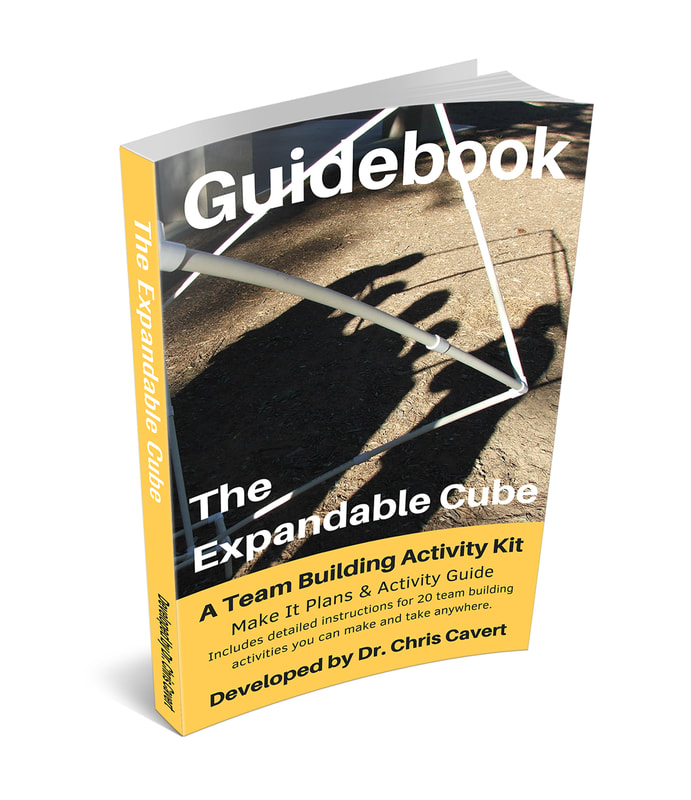ACTIVITY OBJECTIVE: The group is challenged to verbally move through a pattern of each participant’s name as quickly as possible.
FACILITATED OBJECTIVE: Explore behaviors related to communication, cooperation, planning and implementation, participation/active engagement, problem solving, and goal setting. Explore concepts of practice/rehearsal, success/failure, and task pressure.
NEEDS & NUMBERS: You’ll need a spot marker for each player (my favorite spot is a five foot piece of parachute cord tied at the ends to make a circle) and one stopwatch. Plays well with 8 to 16 people. Multiple groups can play at the same time – it’s good to have a stopwatch for each group.
TIME: 10 to 15 minutes (for a few rounds)
PROCEDURE: Have your group form a comfortable circle – double elbow is fine. Have each player stand on (or in) a spot. As in the traditional Warp Speed (often preceded by the activity Group Juggle), the group will first need to set up a passing order. However, in this variation instead of passing an object (done in Warp Speed), the players will be passing names. Before this happens I like to add, “When setting up the name-passing order (NPO), please do not pass your name to a person standing next to you.”
Each player is asked to pass his or her own name once and receive another players name once in the order. For example, Berry starts by saying, “Barry passes to Mary.” Mary then says, “Mary passes to Gretchen.” Gretchen says, “Gretchen passes to George.” This continues until everyone has passed his or her name. The last player to receive a pass (name) in the order passes his name to Barry, “Chris passes to Barry.” Once the NPO is established, ask the group to practice it two or three times to make sure they have it down. At this practice stage I let the players simple say the name of the person he or she is passing to - Barry only needs to say, "Mary" (not "Barry passes to Mary.")
When the NPO is “locked in” the challenge can be presented. With the memorized and practiced order in mind, each person is going to be moving to the spot of the other person they called out in the pattern. So, Barry will be moving to Mary’s spot (Note: based on what you find out in the directions below, Barry will end up being the last person to move – going to Mary’s spot), Mary to Gretchen’s (Mary will be the first person to move), Gretchen to George’s and so on until Chris occupies the spot eventually left open by Barry. This challenge will be timed from the moment Mary leaves her spot to the time when Chris and Barry reach there spots (as well as everyone else being in their appropriate spot). When the group understands the overall idea of the activity, I present the two main rules for clarification:
- A player cannot leave his or her spot until his or her name is called (So, Barry cannot move until Chris calls his name).
- Each player must end up standing in the spot of the player they “passed” to – in the original established pattern.
SAFETY & FACILITATION: If you present this activity early on in your program (I use it for learning names and also as a way to introduce the types of challenges I will be presenting), your group might not get the “shift” in thinking just yet. Those familiar with Warp Speed know that the directions did not say they had to move one at a time or that they had to start in the spot where they created their passing order. The group, for this specific challenge, is only asked to follow the two clarification rules. So, if you do present this one early, you might consider coming back to it after your group has discovered some “shifting” in other activities to see if they can achieve a super-fast time. Or, if you have a group that can really be challenged at the get-go, ask them (give them the goal) to achieve a time under five seconds. This imposed goal might “nudge” them into the shift(s) to be able to solve the problem.
I haven’t run into many safety issues during this one, however, after the “shift” there might be some “running into” problems. As always, stress that everyone’s safety is more important than a fast time.
OBSERVATIONS/QUESTIONS:
- Does everyone know each other’s names at this point? Where do we need practice?
- Think back to the planning part of this activity – what do you remember about it? Did you have a plan? Did everyone know what the plan was? Was there a leader? Did everyone get to share the idea(s) they had?
- Did you improve your process over time? What contributed to your improvement? Will this information be important to remember? Why? Why not?
- What is a phantom rule (a rule made up based on assumptions)? Did you have any phantom rules in place? Did these rules help or hinder your process? What if the phantom rules were eliminated, what could you do?
- Where did your “shift” in thinking come from? Did everyone “buy into” the shift in thinking? If not, why? If so, why?
- Were you successful? Is a fast time the only way you were successful as a team? How do you measure your success? What different measures of success could there be?
- What will you want to remember from this activity?
VARIATIONS:
- You could reverse the passing-order – players "toss the name" to their original tosser.
- For some programs, depending on the group’s objectives, I go into Speed Ball after Name Warp Speed to provide another opportunity to make a paradigm shift in thinking – or, transfer learning. (Speed Ball is coming out in my new activity book early 2014 - keep an eye out for it in the Books section here at FUNdoing!)
Let me know how this one goes for you. Leave your feedback in the comments area below.
Have fun out there!
Chris Cavert







 RSS Feed
RSS Feed